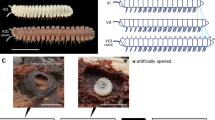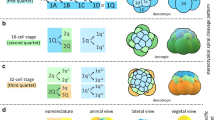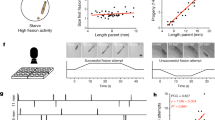Summary
-
1)
The regeneration of a head on the posterior end of a crosspiece ofPlanaria maculata is due to the shortness of the piece; the shorter the pieces the larger the proportion of double-headed worms (Fig.A) that are obtained. Long pieces do not produce heteromorphic heads.
-
2)
Short oblique pieces (Fig.C) also often produce heteromorphic heads. The posterior head lies at the same (lateral) side of the piece as does the anterior head (Fig.C, D, E).
-
3)
If a long cross-piece (Fig.F) is cut out and its ends allowed to begin to regenerate, and if then its anterior end is cut off, there is no greater proportion of double-headed worms obtained than when short cross-pieces have both ends regenerating at the same rate. This result indicates that the development of the heteromorphic head is not due to the influence of the anterior head.
-
4)
Our analysis of the conditions that lead to the devolopment of the heteromorphic heads in short cross-pieces ofPlanaria maculata leads to the conclusion that there is always a stronger tendency in the material that develops over a cut surface to produce a head than to produce a tail, and that a head will appear unless the polarity of the piece is sufficiently strong to overcome this tendency, and cause a tail to regenerate. Long pieces therefore produce a tail at their posterior ends, and only very short pieces, in which the polarity is reduced, a heteromorphic head.
-
5)
A similar explanation is extended to other cases of axial heteromorphosis. In some of these, as in the earthworm, it is assumed that in the anterior region the new material is more strongly predisposed to produce a head, and in the tail region a tail. When the polarity is reduced in these regions the heteromorphic structure appears.
-
6)
Pieces from the side ofPlanaria maculata andPlanaria lugubris that do not include any part of the main nerve cord regenerate a head. The lateral position of the heads in these pieces is probably also connected in part with the lack of strong polarity in the pieces.
Zusammenfassung
-
1)
Die Regeneration eines Hauptes am hinteren Ende eines durch Querschnitte erhaltenen Stücks von Planaria maculata ist von der Kürze des Stücks abhÄngig; je kürzer das Stück, in desto grö\erem VerhÄltnis treten die erhaltenen zweiköpfigen Würmer auf (Fig.A). Lange Stücke produciren keine heteromorphischen HÄupter.
-
2)
Kurze, schrÄg geschnittene Stücke (Fig.C) erzeugen gleichfalls oft heteromorphische HÄupter. Das hintere Haupt liegt auf derselben (lateralen) Seite wie das vordere (Fig.C,D, E).
-
3)
Wird ein langes Stück durch Querschnitte herausgeschnitten und der Regenerationsanfang an seinen Enden abgewartet, darauf sein vorderes Ende abgeschnitten, so treten doppelköpfige Würmer nicht in stÄrkerem VerhÄltnis auf, als wenn bei kurzen Querschnittsstücken die Regeneration beider Enden gleich weit fortgeschritten ist. Dieses Ergebnis zeigt, dass die Entwickelung des heteromorphischen Hauptes nicht auf einem Einfluss des vorderen Hauptes beruht.
-
4)
Unsere Analyse der Bedingungen für die Entwickelung heteromorphischer HÄupter an kurzen Querstücken von Planaria maculata führt zu dem Schluss, dass das an einer SchnittflÄche sich entwickelnde Material stets eine stÄrkere Tendenz hat, einen Kopf als einen Schwanz hervorzubringen und dass ein Haupt erscheint, au\er wenn die PolaritÄt des Stücks stark genug ist, jene Tendenz zu überwinden und die Regeneration eines Schwanzendes zu veranlassen. Lange Stücke bringen daher einen Schwanz an ihrem Hinterende hervor, und nur ganz kurze Stücke, in denen die PolaritÄt reducirt ist, erzeugen ein heteromorphisches Haupt.
-
5)
Eine Ähnliche ErklÄrung erstreckt sich auf andere FÄlle axialer Heteromorphosis. In einigen von ihnen, wie beim Regenwurm, wird angenommen, dass das Material am Vorderende stÄrker zur Erzeugung eines Hauptes prÄdisponirt ist, in der Schwanzregion entsprechend zu der eines Schwanzes. Wird die PolaritÄt reducirt, so erscheint in diesen Bezirken das heteromorphische Haupt.
-
6)
Aus den Seitenbezirken von Planaria maculata und Planaria lugubris entnommene Stücke, welche keinen Theil des Hauptnervenstranges enthalten, regeneriren ein Haupt. Die seitliche Stellung der HÄupter bei diesen Stücken hÄngt wahrscheinlich mit dem Mangel starker PolaritÄt bei diesen Stücken zusammen.
Similar content being viewed by others
Rights and permissions
About this article
Cite this article
Morgan, T.H. The control of heteromorphosis in Planaria maculata. Archiv für Entwickelungsmechanik der Organismen 17, 683–695 (1904). https://doi.org/10.1007/BF02161815
Received:
Issue Date:
DOI: https://doi.org/10.1007/BF02161815




